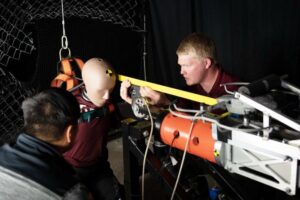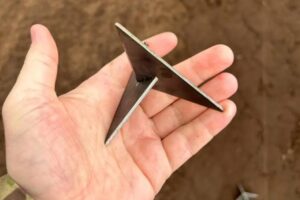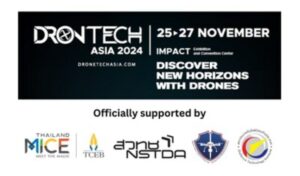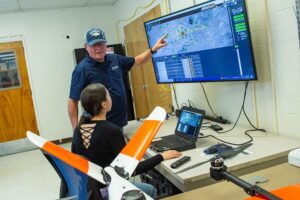When you purchase the DJI Avata 2 Fly More Combo, you get three big items: the Avata 2 drone itself, plus a pair of DJI Goggles 3 (those are the first person view [FPV] goggles) and a unique type of controller called the DJI RC Motion 3. But what about the DJI FPV Remote Controller 3?
The DJI FPV Remote Controller 3 is offered as an add-on accessory to go with your DJI Avata 2 Fly More Combo for an additional $199 fee. Should you purchase it? Here’s a deep dive into what it is, why you might opt for it over the DJI RC Motion 3, and some spicy drone pilot opinions on how DJI could make the DJI Avata 2 Combo more consumer-friendly:
DJI FPV Remote Controller 3: is the upgrade worth it?
The differences between the DJI RC Motion 3 versus DJI FPV Remote Controller 3

When you buy the DJI Avata 2 Fly More Combo ($999), the DJI RC Motion 3 is already included. The DJI RC Motion 3 is certainly a neat little product. It’s intended to be much more beginner-friendly than the DJI FPV Remote Controller 3.
By the way, check out my full DJI Avata 2 review here.
How the DJI RC Motion 3 works
Whereas the DJI FPV Remote Controller 3 has two joysticks that require some skill, the DJI RC Motion 3 does pretty much everything through the combination of you tapping a few buttons and flicking your wrists. Yes, the drone’s motion responds to your wrist movements as you hold the DJI RC Motion 3.
From there, a series of buttons allow you to takeoff, stop, switch modes, and even execute fancy acrobatic maneuvers. There is one joystick, which allows you to control the aircraft’s ascent, descent, or horizontal movement to the left or right.
The RC Motion 3 features a two-stop throttle design. The first stop allows rapid adjustment of the drone’s pitch while hovering, and the second stop controls the flight speed depending on how much pressure is applied.
A half-press of the throttle trigger locks the drone in the first stop, keeping its attitude stable. That half-press prevents the drone from spinning due to remote controller jitters during hovering. The benefit? You may avoid dizziness as perceived through the flight goggles.
Fully pressing the trigger engages the second stop, unlocking the attitude and increasing the throttle.
RC Motion 3 versus DJI FPV Remote Controller 3
But you might want the DJI Remote Controller 3, which looks more like your standard controller. It’s the only way you can fly the Avata 2 in Manual mode.
Here are the two controllers, compared:
| Feature | DJI FPV Remote Controller 3 | DJI RC Motion 3 |
|---|---|---|
| Control Style | Traditional Dual Sticks | Motion Control |
| Learning Curve for brand-new pilots | Steeper (More Precise) | Lower (More Intuitive) |
| Ideal for | Precision flying, experienced pilots | Freestyle flying, beginners |
| Battery Life | Up to 10 hours | Up to 10 hours |
| Charging Time | About 2 hours | About 2 hours |
| Weight | 240 grams | 118 grams |
| Modes | Normal, Sport, Manual | Normal, Sport (Software Select) |
| Price | $199 | Included with Avata 2 Explorer Combo (which costs $999) Otherwise sold separately for $99 |
| When is it best used? | If you want to fly in manual mode | If you want to execute flight manuevers with one tap |
Buying the add-on DJI FPV Remote Controller 3: the pros and cons
With those differences in mind, here are the pros and cons of upgrading to the DJI FPV Remote Controller 3:
Pros
Manual control mode: You can not fly in manual control with the DJI RC Motion 3, marking the primary reason why most people would choose the DJI FPV Remote Controller 3 over the RC Motion 3.
Compatibility with drone flight simulators: If you want to practice using drone flight simulators, the DJI FPV Remote Controller 3 is there for you. This RC is compatible with popular simulators including Liftoff, Uncrashed, The Drone Racing League and DCL.
Cons
Really the only con here is cost. But is it worth the price?
After all, the brand-new RC Motion 3 enables one-press execution of various aerobatic maneuvers not limited to M-mode FPV Remote Controller users.
This version of the RC Motion 3 has also gotten some serious upgrades. For example, pilots can now combine the dial and button on the RC Motion 3 with hand movements to perform one-press flips, one-press rolls, and one-press 180° yaw splits. It’s also smaller and lighter than its predecessor, offering a much more comfortable grip.
When the DJI FPV Remote Controller 3 is worth it?
For many pilots, the whole set is only complete with the DJI FPV Remote Controller 3. That lets you master more sophisticated skills and fly more accurately.
DJI FPV Remote Controller 3 versus Remote Controller 2
The DJI FPV Remote Controller 3 also marks a huge improvement over the old DJI FPV Remote Controller 2 given its DJI O4 video transmission and integrated antenna design. It’s also lighter than its predecessor and boasts a longer operating time. Here’s a look at how much better the version 3 is over version 2:
| Feature | DJI FPV Remote Controller 3 | DJI FPV Remote Controller 2 |
|---|---|---|
| Control Style | Traditional Dual Sticks | Traditional Dual Sticks |
| Battery Life | Up to 10 hours | Up to 9 hours |
| Charging Time | About 2 hours | About 2.5 hours |
| Weight | 240 grams | 346 grams |
| Dimensions | 165mm length 119 mm width 62 mm height |
190mm length 140 mm width 51 mm height |
| Compatible with | DJI Avata 2 DJI Goggles 3 |
DJI Avata DJI FPV DJI Goggles 2 DJI Goggles Integra DJI FPV Goggles V2 |
| Price | $199 | $199 |
Since they’e compatible with completely different pieces of equipment, you’re not really choosing between the Remote Controller 2 versus 3. But, use the information above to see just how much better this new RC got in the upgrade.
Buying the DJI FPV Remote Controller 3
Total cost of DJI Avata 2 Fly More Combo + FPV Remote Controller 3 ($1,198): Most people buying the DJI Avata 2 will purchase the DJI Avata 2 Fly More Combo. To add on the FPV Remote Controller 3, you’ll owe $199, for a grand total of $1,198.
Total cost of DJI Avata 2 + FPV Remote Controller 3 + DJI Goggles 3 ($1,187): That said, if you really don’t want the RC Motion 3, you can buy items a la carte. DJI sells the Avata 2 drone only for just $489.
Since you cannot use DJI Avata 2 without goggles, you’ll likely need to spend $499 for the DJI Goggles 3. That said, previous generation goggles are also compatible with Avata 2. Thus, you can avoid that fee by using goggles you might already have. Or, you could simply save money by buying older models of goggles). The DJI Goggles 2 retail for $449 as of April 2024, and the DJI Goggles Integra retail for just $349.
Then, you could drop $199 on the DJI FPV Remote Controller 3.
Technically you save $11 if you go that route, but then you don’t get the Motion Controller 3 at all. I’d rather buy the DJI Avata 2 Fly More Combo + FPV Remote Controller 3 for $11 more.
But if you already have goggles (and don’t mind the older model), then you could pay just $688 for the new Avata 2 drone and DJI FPV Remote Controller 3. I absolutely love the new goggles, as the integrated headband is way less clunky and way more comfortable. But unless you’re looking for ways to burn cash, they likely wouldn’t be worth paying all that extra money for in most cases.
- Buy the Avata 2 drone now from Adorama.
- Buy the Avata 2 drone now from Amazon.
- Buy the Avata 2 drone now from B&H Photo.
- Buy the Avata 2 drone now from GetFPV.
What DJI drone pilots really want

Since the Avata 2’s launch, some pilots have suggested their own idea: the option to choose between the DJI RC Motion 3 and the traditional dual-stick controls offered by the DJI FPV Remote Controller 3.
There are a few reasons why DJI might default to including the RC Motion 3 with the Avata 2, which might be:
- Learning curve for beginners: The Motion Controller’s intuitive motion controls could have a lower learning curve for absolute beginners compared to traditional sticks. This could encourage wider adoption of the FPV system, especially for those intimidated by complex controls.
- Focus on freestyle flying: The Motion Controller’s design is well-tailored for freestyle flying. That’s a popular use case for the Avata 2.
- Acro Mode Accessibility: The emphasis on the Motion Controller could be DJI’s way of forcing pilots to engage with DJI’s software-based mode switching, which might include Acro mode more prominently.
Which controller do you like better? The FPV Remote Controller 3 or the DJI Motion Controller 3? Tell me in the comments!
And if you prefer the FPV Remote Controller 3, does that mean you’ll pay $200 extra for it? Again, share your ideas with the Drone Girl community below!
- Buy the Avata 2 drone now from Adorama.
- Buy the Avata 2 drone now from Amazon.
- Buy the Avata 2 drone now from B&H Photo.
- Buy the Avata 2 drone now from GetFPV.
The post DJI FPV Remote Controller 3: is it worth adding to your Avata 2 kit? appeared first on The Drone Girl.










